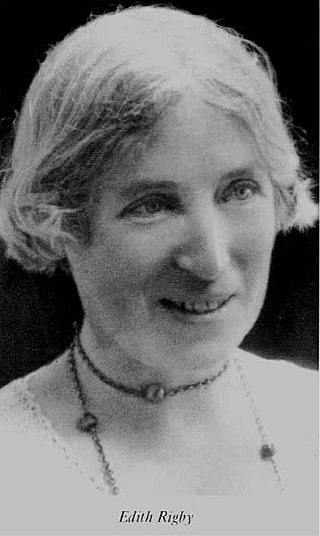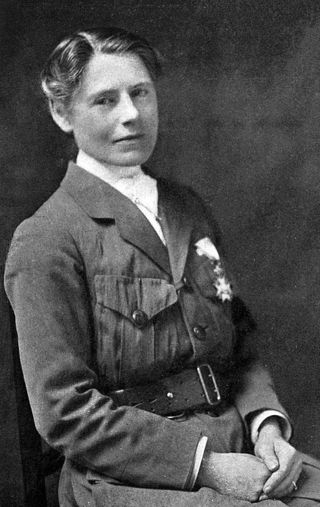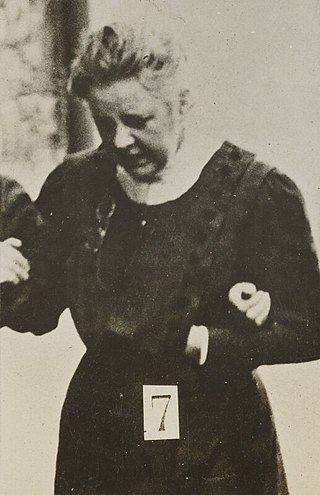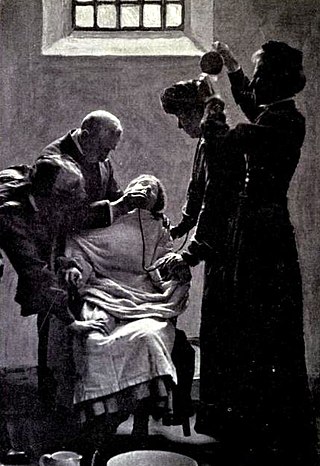Related Research Articles

Edith Rigby was an English suffragette who used arson as a way to further the cause of women’s suffrage. She founded a night school in Preston called St Peter's School, aimed at educating women and girls. Later she became a prominent activist, and was incarcerated seven times and committed several acts of arson. She was a contemporary of Christabel and Sylvia Pankhurst.

Christina Broom was a Scottish photographer, credited as "the UK's first female press photographer".

Evelina Haverfield was a British suffragette and aid worker.

Mairi Lambert Gooden Chisholm, of Chisholm, MM, OStJ, known as Mairi Chisholm, was a Scottish nurse and ambulance driver in the First World War. She, together with her friend Elsie Knocker, won numerous medals for bravery and for saving the lives of thousands of soldiers on the Western Front in Belgium. Dubbed "The Madonnas of Pervyse" by the press the two were among the most photographed women of the war.

Ernestine Evans Mills was an English metalworker and enameller who became known as an artist, writer and suffragette. She was the author of The Domestic Problem, Past, Present, and Future (1925). Three pieces of jewellery that Mills created for the suffragettes are in the Museum of London.

Rose Elsie Neville Howey, known as Elsie Howey, was an English suffragette. She was a militant activist with the Women's Social and Political Union and was jailed at least six times between 1908 and 1912.

Gertrude Mary Ansell was a British suffragette, animal welfare activist and businesswoman.
Annie Barnes was a British-Italian socialist and suffragist.

Florence Eliza Haig (1856–1952) was a Scottish artist and suffragette who was decorated for imprisonments and hunger strikes.

Lucy Minnie Baldock was a British suffragette. Along with Annie Kenney, she co-founded the first branch in London of the Women's Social and Political Union.

Adelaide Knight, also known as Eliza Adelaide Knight, (1871–1950), was a British suffragette.

Women's Sunday was a suffragette march and rally held in London on 21 June 1908. Organised by Emmeline Pankhurst's Women's Social and Political Union (WSPU) to persuade the Liberal government to support votes for women, it is thought to have been the largest demonstration to be held until then in the country.

Elsa Gye (1881–1943) was a music student at Guildhall who became a suffragette and involved in disruptive events in London and Scotland and was imprisoned for the cause of women's suffrage.

Grace Alderman was a British suffragette, chairwoman of the Preston Women's Social and Political Union (WSPU) and involved in militant events in London and Preston, and was imprisoned for protesting for women's suffrage.

Violet Aitken was a British suffragette. She was born Marion Violet Aitken and raised in Bedfordshire, and she was the daughter of William Aitken, who became Canon of Norwich Cathedral. She had a sister, Rose, who took up theosophy.

Olive Beamish was an Irish-born suffragette, who wore a Women's Social and Political Union (WSPU) badge whilst still at school, and became involved in the militant suffragette movement, including attacking postboxes and arson. Beamish was also known as "Phyllis Brady". Beamish was imprisoned and force-fed and was one of the first to be released under the "Cat and Mouse" Act and later sentenced to 18 months with hard labour.

The Hunger Strike Medal was a silver medal awarded between August 1909 and 1914 to suffragette prisoners by the leadership of the Women's Social and Political Union (WSPU). During their imprisonment, they went on hunger strike while serving their sentences in the prisons of the United Kingdom for acts of militancy in their campaign for women's suffrage. Many women were force-fed and their individual medals were created to reflect this.
Elise Eugenie Mathilde Wolff Van Sandau was a British suffragette. She was imprisoned three times, for smashing windows and went on hunger strike. She was awarded the Women's Social and Political Union Hunger Strike Medal 'for Valour'. She was also a musician and a founder of London's women's chess club and an active vegetarian. Research by the British Library suggests that she used different spellings of her name, including Elsie when arrested as a suffragette.

The Suffragette Handkerchief is a handkerchief displayed at The Priest House, West Hoathly in West Sussex, England. It has sixty-six embroidered signatures and two sets of initials, mostly of women imprisoned in HMP Holloway for their part in the Women's Social and Political Union Suffragette window smashing demonstrations of March 1912. This was an act of defiance in a prison where the women were closely watched at all times.
British suffragists in the early 20th century, who were siblings
References
- ↑ Atkinson, Diane (2018). Rise Up, Women! The Remarkable Lives of the Suffragettes. London: Bloomsbury. ISBN 978-1408844045. OCLC 1016848621.
- ↑ Barrow, Andrew (1 January 2006). "Patrick Hughes: Double trouble". The Independent.
- ↑ Atkinson, Diane (1992). The Purple, White and Green: Suffragettes in London (catalogue). Museum of London.
- ↑ Joannou, Maroulla (August 1998). "To defend the oppressed". Gender and History (review of The Suffragettes in Pictures). 10 (2): 312–315. doi:10.1111/1468-0424.00104. S2CID 143918493.
- ↑ Hughes, Kathryn (18 January 2003). "Book of the Week: A good roll in the muck". The Guardian (review of Love and Dirt).
- ↑ Lane, Victoria (25 January 2003). "A Dust Wench". The Telegraph (review of Love and Dirt).
- ↑ Upstairs Downstairs Love
- ↑ "Elsie and Mairi Go To War – Press Release" (PDF).